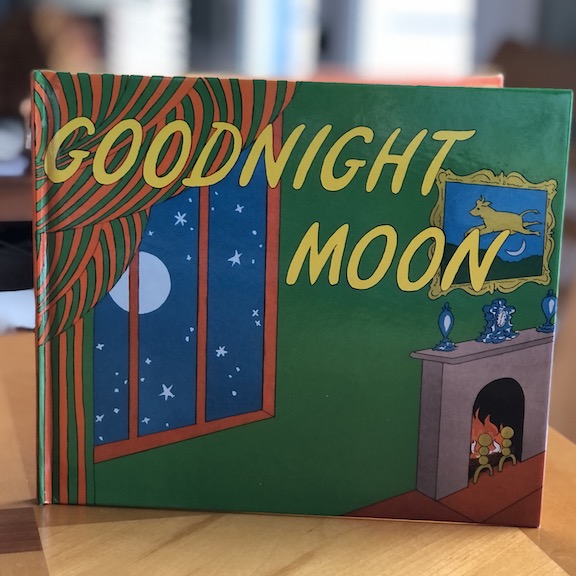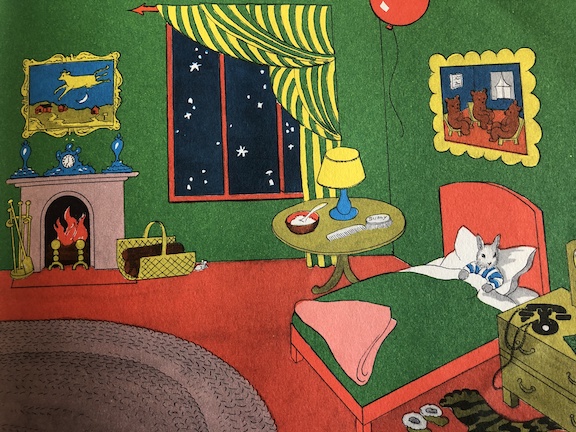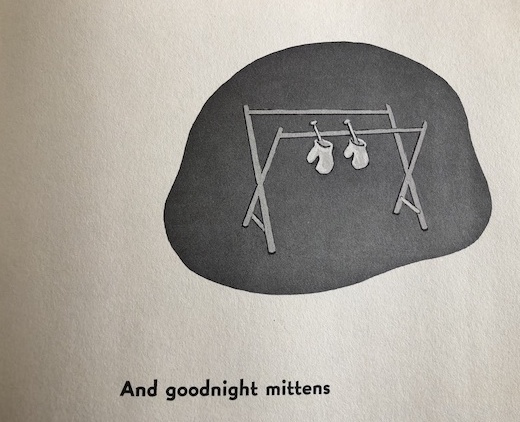Goodnight Moon book for Bedtime

The Goodnight Moon book by Margaret Wise Brown is a classic bedtime book for young children.
It begins...
In the great green room
There was a telephone
And a red balloon
And a picture of -
The soothing rhythm of Goodnight Moon has rocked many a child to sleep over the past 74 years! I would say that makes this a classic bedtime story for children.
Margaret Wise Brown based this sweet tale of a bunny telling its toys and surroundings goodnight on her own childhood bedtime routine of doing the same herself.

Here are a few things to add to your reading time to enhance your child's development. I am not suggesting doing all these at one time nor making this classic bedtime story into a text book!
The joy of sitting with you reading a book together is the most important aspect of reading with a child. These are just a few "add-ons" along the way to help your child grow.
As your child grows, Goodnight Moon can grow with them!
Make the Most of the Sounds
Rhythm - Science has shown us that both the rhythm of reading and the sound of your voice impacts a child's brain development as well as laying neural pathway foundations for reading.
Rhyme - As children become aware of rhyming sounds, it boosts brain activity and prepares them for early literacy skills.
Repetition - The repetitiveness of text is like waving a flag to a baby or toddler saying they've heard this before...listen carefully.
What to do:
- Read the book to yourself a few times first to get a natural flow of rhythm.
- Take your time. The Goodnight Moon book only has a total of 130 words; do not rush them. Read slowly and smoothly like rocking your child to sleep.
- As your child gets older, allow them to chime in with a few of the rhyming words to finish the sentences and also whisper "hush" with the old lady. Allow them to become part of the story.
- This Goodnight Moon book hints at other stories and rhymes. Use this book as a jump-off to introduce these such as: the cow jumping over the moon points to "Hey, Diddle, Diddle"; the picture of the three bears to the story of Goldilocks; kittens and mittens point to the the rhyme of the three kittens who lost their mittens.
Make the Most of the Pictures

- The Goodnight Moon book illustrations alternate from full, bright colors to black and white every other page. As children grow, help them notice the pattern and "predict" which will be next. This also gives them a reason to pay close attention. Ask if they notice any other patterns. (hint: the colored pages become darker and darker)
- Clement Hurd, the illustrator of the Goodnight Moon book includes several small details in pictures.
- Play "I Spy" with your child asking if they can find: the blue clock, a red arrow, a red barn, small giraffe, a rabbit fishing, a pair of slippers, an elephant, etc. This helps children learn to notice and appreciate the details of book illustrations.
- Hurd also includes a small mouse to find in each of the multicolored spreads.
- Play "I Spy" with colors...I spy something blue on this page.
Make the Most of the Words
Intellectual Development
Toddlers
- Colors - Practice learning colors with the bold primary colors included in the illustrations. Where is the red balloon? What else is red in the room? What color is the bookshelf? What else is yellow?
- Counting - Toddlers are also beginning to count. Have them count the three bears mentioned in the story. Count the mittens and kittens. Count how many times they see the little mouse throughout the book. Count the number of times they see the moon, etc.
- Vocabulary - Talk about words in the book they may not know like mush. Read "and a bowl full of mush." What do they think mush is? Or "whispering"; practice whispering the story or the word hush. Why do we whisper?
Emerging Readers
- Point out beginning sight words including color words and number words as you read.
- Point out how the words kittens and mittens not only sound the same, but look the same along with house & mouse, brush, mush & hush, etc.
- Let your child read "goodnight" throughout the reading.
- Begin matching pictures to words. Point to the bears and ask your child if they can find the matching word. Sound out each letter together as they are looking. Repeat with other words such as kittens, mittens, clock, chairs, etc. This helps even very young children understand the connection between the words you say and the written words in the book. It also gives practice with phonemes, the sound of letters.
- Talk about the phoneme of "oo", and how it sounds in moon versus how it sounds in good. Have your child think of other words with these sounds and match them. Example: "oo" in moon is the same as tooth, food and room. "oo" in good is the same as book, foot and look.
- Practice rhyming. Help your child think of other words that rhyme with words in the Goodnight Moon book such as: bear, chair, fair, wear, mare, etc. or light, night, right, sight, etc.
- Memory test - Comprehension is one of the most important elements of reading. If a child only reads the words without understanding the text, they will struggle throughout life.
- Use stories like the Goodnight Moon book to help children begin retaining what is read. After reading through the book, ask questions such as - What happened at the beginning? What happened next? What happened at the end? This is called sequencing and an important part of comprehension.
- Ask your child if they remember what the old lady was doing, what color the room was, what was in the bowl, etc. Asking questions helps a child realize it is important to pay attention to the details of what they read as well as what is pictured in the story.
Make the Most of the Message
of the Goodnight Moon book
You may be thinking there is not enough story in this Goodnight Moon book to have a message. That's where we need to take a step closer; help your child think beyond the 130 words.

Social Development
- Use the backdrop of the Goodnight Moon book to ask children several questions they may not have considered. Let the book become a communication starter. Ask who else may live at the little bunny's house. Who do they think the little old lady may be. Take time to talk about families and homes.
- Pets can be nice companions. In the book there are two kittens. Talk about pets. Ask if they think the kittens helped the bunny go to sleep. What type of pets may help?
- How things have changed through time...have your child notice things in the book that are different from what we use today such as the telephone, clocks, toys and entertainment,
Emotional Development
- Afraid - Many times children are afraid of night time and the dark. As the pictures become darker and darker depicting the story getting later, talk about things that can help us not be afraid of the dark. Make sure your child knows they can talk about their feelings and struggles.
- Loneliness - Little bunny is all alone except for the little old lady. Ask if they think he might feel lonely; ask when they feel lonely.
- Comfort - What things in the story may have comforted the little bunny? What things bring comfort to your child? Share your own thoughts.
Spiritual Development
One thing that really jumps out at me is the constants in the Goodnight Moon book. The bunny is surrounded by familiar things he says goodnight to, things he counts on to be there.
The moon is one constant God has put in the night sky for us to see. Even if we are separated from those we love, we see the same moon no matter where we are.
God is also constant and consistent. He is faithful and can be trusted. This may be one of the most important characteristics a child needs to understand about Him. He can be counted on no matter what. Even when people may let us down, God is there.
The Bible story of the Prodigal Son give s a beautiful illustration of how much God loves and faithfully waits to welcome us back to Him.
Here are a few Bible verses to read with your child:
Deuteronomy 7:9 - "Know therefore that the Lord your God is God; he is the faithful God, keeping his covenant of love to a thousand generations of those who love him and keep his commandments."
Numbers 23:19 - "God is not human, that he should lie, not a human being, that he should change his mind. Does he speak and then not act?Does he promise and not fulfill?"
Hebrews 13:5 - "Keep your lives free from the love of money and be content with what you have, because God has said, “Never will I leave you; never will I forsake you.”
Hebrews 13:8 - "Jesus Christ is the same yesterday and today and forever."
James 1:17 - "Every good and perfect gift is from above, coming down from the Father of the heavenly lights, who does not change like shifting shadows."


